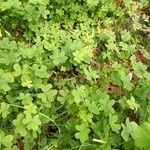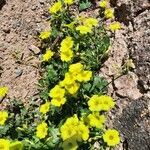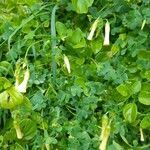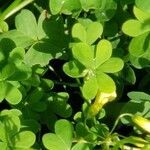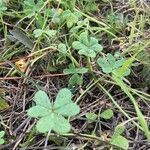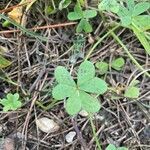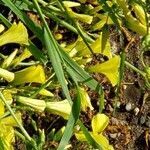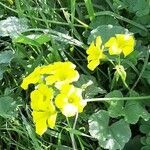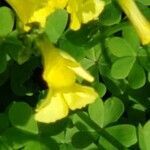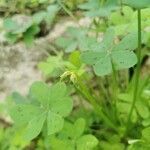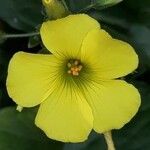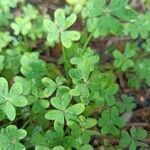Perennial herb, apparently acaulous but with underground stolons bearing numerous bulbils near the apex; contractile roots thick, fleshy, glassy white; bulb to c. 3 cm long, ovoid; tunic pale brown, 5-7-nerved. Lvs 3-foliolate, radical. Petiole 6-22 cm long, ± hairy; stipules membranous, glabrous or nearly so. Lamina sessile (that of terminal leaflet somewhat larger than laterals), 10-32 × 12-35 mm, shallowly to deeply 2-lobed to c. 1/2 way, glabrous above, ± sericeous and finely reticulate below; base narrow-cuneate; lobes oblong to almost obovate; apex rounded. Fls (1)-3-18, in pseudoumbels, pendent; peduncles (7)-15-45 cm long, glabrous to sparsely hairy; pedicels to 2 cm long, densely clothed in glandular hairs. Bracts at base of pedicels, c. 2.5 mm long, lanceolate, hairy, with apical calli. Sepals 5-6.5 mm long, lanceolate or oblong-lanceolate, with glandular hairs mainly towards base, or nearly glabrous; calli 2, apical, usually orange, sometimes yellow. Petals (1.5)-2-2.8 cm long, obovate with narrow claw, golden, sometimes red-margined, with appressed hairs outside or almost glabrous. Stamens at 2 levels, glabrous; filaments appendaged below, c. 7 mm long in the 2 common stylar morphs, 5 mm long in the rare long-style morph. Styles either < or nearly = lower stamen whorl (short-styled clone), > lower stamen whorl (mid-style clone), or = or > upper stamen whorl (long-style clone), hairy. Capsule not seen.
Herbs perennial, acaulous, rhizomes present <vertical, white, rootlike>, stolons absent, bulb usually solitary, sometimes with bulblets at base; bulb scales not observed. Leaves basal, <rarely absent at flowering>; petiole 3–12 cm; leaflets 3, green, rarely mottled with purplish red spots, angular-obcordate, (5–)7–20 mm, lobed 1/4–2/5 length, <lobes apically convex, margins and> abaxial surface villous, adaxial surface glabrous, oxalate deposits absent. Inflorescences umbelliform cymes, 2–12(–20)-flowered; scapes <often becoming fistulose proximally>, 15–30 cm, sparsely villous to pilose. Flowers tristylous in diploids and tetraploids, consistently short-styled in pentaploids; sepal apices with 2 orange tubercles; petals deep golden yellow, 15–20 mm. Capsules not seen. 2n = 14, 28, 35.
Perennials, 5-15(-40) cm tall, acaulescent, sparsely pubescent; bulb with white fleshy contractile root and a slender vertical stem rising to soil surface; underground stem and soil surface crown bearing numerous small bulbils and scales. Petiole 3-10 cm, erect to spreading; leaflet blades obcordate, 0.8-2 × 1.2-3.2 cm, slightly succulent, bright green often with dark purple spots, glabrous, apex deeply emarginate. Umbellate cymes with 3-20 flowers; peduncle 2 × as long as petioles. Flowers 2-3 cm across, nodding. Sepals lanceolate, 2.5-4 × ca. 1 mm, apex with a pair of orange calli. Petals deep golden yellow, obovate. Capsule long terete, pubescent, very rarely formed. Fl. Apr-Sep.
A herb which keeps growing from year to year. It has an underground stem which produces many bulbs. The leaves have 3 leaflets are are arranged in a ring near the base. The leaflets have 2 lobes. They are on long leaf stalks. The leaflets have a few stiff hairs underneath. The flower stalks arise from the base and are longer than the leaves. There can be 3-16 flowers in a cluster. The flowers are large and yellow. The petals are 2-2.5 cm long.
Acaulescent to caulescent geophyte, up to 0.35 m high. Bulbs pale brown, ovate-oblong. Stem up to 0.1 m long. Leaves apically congested, trifoliolate, leaflets subbilobed, cuneate-obcordate. Peduncles 3-20-flowered. Flowers yellow. Flowering time June-Oct.
Robust acaulescent or caulescent geophyte, up to 300 mm tall. Bulb tunics soft, brown. Leaves usually basal, suberect, often long-petiolate, leaflets 3, cuneate-obcordate, usually glabrous above, pubescent beneath. Flowers 3-20 per peduncle, yellow.
Acaulescent geophyte. Leaves usually basal, trifoliolate, leaflets cuneate-obcordate, usually glabrous above, pubescent beneath. Flowers 3-20 per peduncle, yellow.
